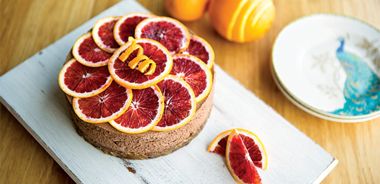Silky Chocolate Blood Orange Cheesecake

Slightly sour with a marbled ruby interior and berrylike flesh, blood oranges are at their peak right now. Paired with rich chocolate and creamy cashews, this is a perfectly sweet, seasonal (and vegan!) ending to any spring feast.
Crust
1 cup (250 mL) walnuts
1 cup (250 mL) packed, pitted Medjool dates (about 8)
1/4 tsp (1 mL) sea salt
Filling
2 cups (500 mL) raw unsalted cashews, soaked overnight in water, drained, and rinsed
2/3 cup (160 mL) coconut oil, melted
1/4 cup (60 mL) maple syrup, plus more to drizzle
1/3 cup (80 mL) cocoa powder
Zest of 1 blood orange
1/4 cup (60 mL) blood orange juice
1 tsp (5 mL) vanilla extract
1/4 tsp (1 mL) sea salt
1 blood orange, cut into thin rounds, for serving
Line 7 in (18 cm) springform pan with a round of parchment paper. Set aside.
To make crust: In food processor, pulse walnuts until rough flour is formed. Add dates and salt, pulsing until fully combined. Firmly press into bottom of prepared pan. Chill while preparing filling.
To make filling: In food processor, blend cashews until creamy. Add remaining ingredients, blending until very smooth, 1 to 2 minutes. Pour into prepared crust. Freeze for at least 6 hours.
To serve, run knife around edge of pan to loosen cheesecake. Unhinge pan and place cheesecake on serving platter. Allow to sit at room temperature for 10 to 20 minutes, or until soft enough to slice.
Garnish each piece with a slice of blood orange and drizzle with additional maple syrup to sweeten, if desired.
Leftovers can be kept well covered in the freezer for up to 1 month.
Serves 8.
Each serving contains: 542 calories; 10 g protein; 42 g total fat (19 g sat. fat, 0 g trans fat); 42 g total carbohydrates (26 g sugars, 5 g fibre); 153 mg sodium
source: "Early Spring Produce", alive #389, March 2015





